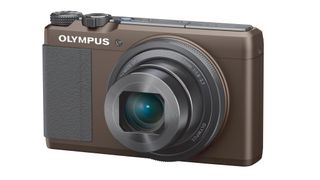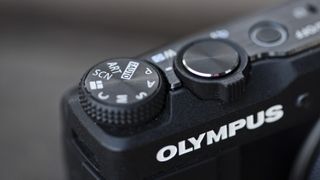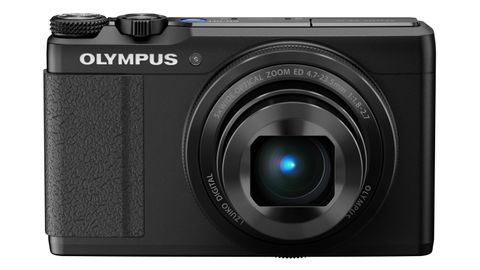Why you can trust TechRadar
Olympus says that the XZ-10 is around 40 per cent smaller than the Olympus XZ-2. We think this makes it a more appealing camera for those looking for something small and light to use every day.
It does mean sacrificing certain elements (no room for a tilting or articulating screen, or a wide array of dials and buttons), but we can forgive something this sleek for that.
Despite its small size, it's still weighty enough to give it a quality feel. The grip is much less pronounced than on the Olympus XZ-2, but a rubberised texture helps to give purchase, especially when you're shooting one-handed.

The depth of the camera is much smaller, and as such the grip on the back is also less pronounced, but again, a small area of rubberised coating is present.
The layout of the Olympus XZ-10 is very similar to the Olympus XZ-2, albeit on a smaller scale. One of the key differences, though, is the lack of a second Function button, found on the front of the Olympus XZ-2.
The most notable difference, however, is the screen, which on the Olympus XZ-2 is a tilting device. Here instead is a fixed screen - it's still touch sensitive though.

You can select an autofocus point via the touchscreen, simply by tapping on whichever bit of the screen you want to set the point to. Alternatively, you can also elect to have the shutter triggered in this way - tapping the screen will focus and release the shutter at the point you choose. If you prefer not to use the touchscreen at all, you can switch off via the screen itself.
To change the AF point without the touchscreen, you need to press a dedicated button on the back of the camera - acting as the left directional key on the four-way pad. After pressing it, use the arrow keys or the scroll dial to the point you want.
It's great to see a touchscreen on a camera of this calibre, and it's something that elevates it above the Nikon P330. It's very responsive in use and makes grabbing those quick shots very easy, and takes the frustration out of changing the autofocus points. It's particularly useful when shooting at wide apertures or in macro focusing mode.

Navigating the rest of the Olympus XZ-10's controls is very similar to the Olympus XZ-2, and indeed, many of the other cameras currently on offer from Olympus - perhaps most notably the PEN series. If you're familiar with any of these models, this would make an excellent second shooter for your pocket.
At the top of the camera is a mode dial for quickly switching between the various modes on offer, including fully automatic, semi-automatic and fully manual. It's also here that you can access art modes and the new montage (Photo Story) feature.
This is a fun new feature that enables you to frame a set of pictures together in one montage. There are many apps available for smartphones that do this, so it's nice to see a similar function making an appearance here. A range of presets are available, which are good fun to play with.

Similarly, anyone who's familiar with Olympus products will know of the company's love for digital art filters, and many of those available on the PEN and OM-D range show up here.
Around the Olympus XZ-10's lens is a ring that can be customised for different uses, including altering the aperture and shutter speed (when in semi-automatic and manual modes). This ring changes function depending on the mode you're shooting in - for instance, in Art mode, the ring switches between the different filters. A dial around the four-way navigational pad is used to alter exposure compensation.
On the back of the camera is a Function button for quickly accessing other key parameters, such as white balance and ISO. This can also be customised to only include the functions you use most frequently.
It's not necessary to delve into the main menu too frequently, because a sort of quick menu can be accessed by pressing the OK button in the centre of the four-way directional pad. Here you'll find fairly in-depth access to settings such as white balance, ISO, aspect ratio, art filter and more.
Amy has been writing about cameras, photography and associated tech since 2009. Amy was once part of the photography testing team for Future Publishing working across TechRadar, Digital Camera, PhotoPlus, N Photo and Photography Week. For her photography, she has won awards and has been exhibited. She often partakes in unusual projects - including one intense year where she used a different camera every single day. Amy is currently the Features Editor at Amateur Photographer magazine, and in her increasingly little spare time works across a number of high-profile publications including Wired, Stuff, Digital Camera World, Expert Reviews, and just a little off-tangent, PetsRadar.


